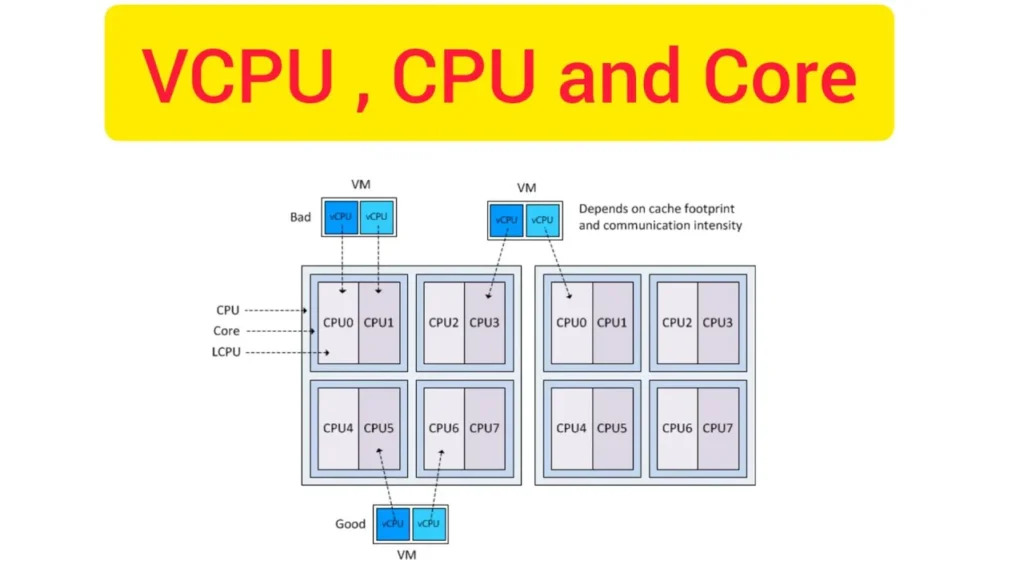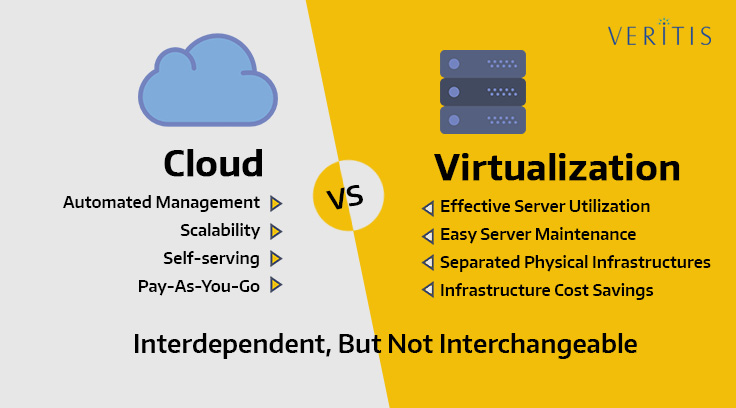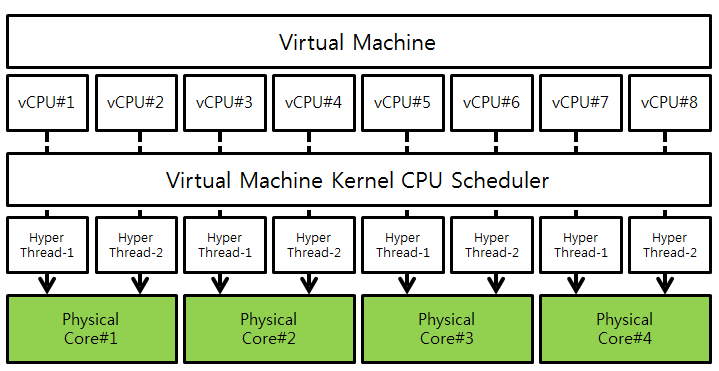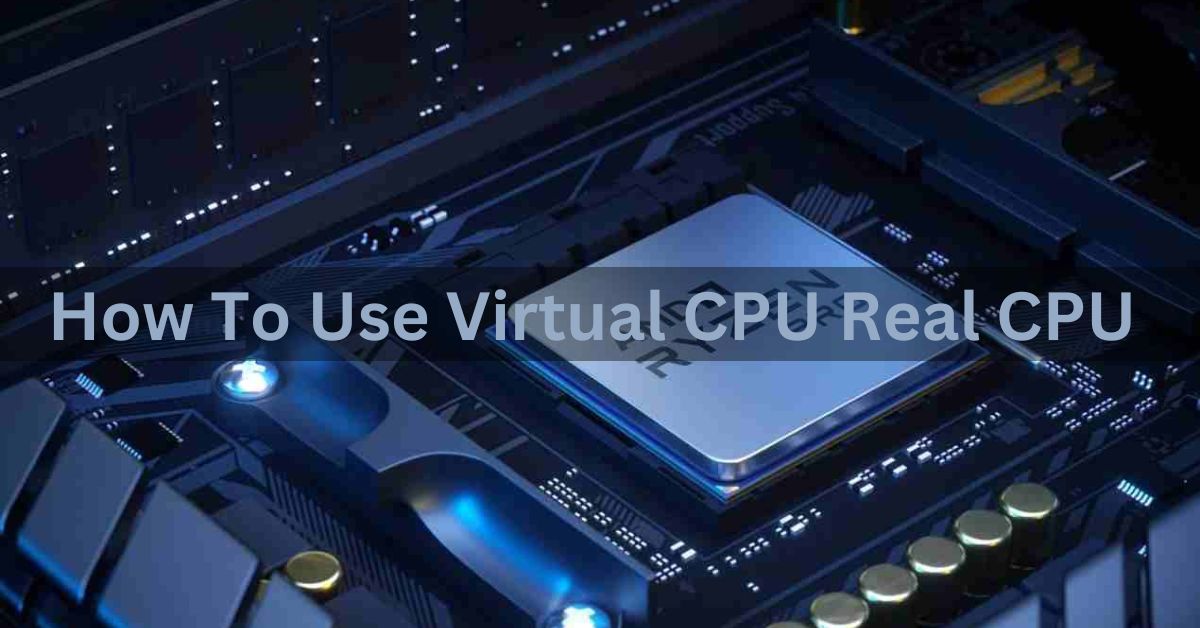Choosing between a virtual CPU (vCPU) and a real CPU is key for optimizing computing resources. Real CPUs are best for tasks needing dedicated, uninterrupted power, while vCPUs provide flexible, cost-effective performance in cloud and virtual environments. Understanding their roles can help balance scalability and budget【8†source】【9†source】.
“Using a virtual CPU (vCPU) lets multiple virtual machines share the resources of a single physical CPU, enabling efficient multitasking, though with potentially reduced performance compared to a dedicated CPU【7†source】【8†source】【9†source】.”
In this article, We will discuss “ How To Use Virtual CPU O Real CPU”
Table of Contents
Understanding Virtual CPU (vCPU) and Physical CPU (Real CPU):

What is a Real CPU:
A real CPU, often referred to as a physical CPU, is the main processing chip in a computer. It executes calculations, performs computations, and processes commands directly, without the need for virtualization layers.
Today’s CPUs generally include multiple cores (physical processing units) and threads (subdivisions of each core) to handle several tasks simultaneously. CPUs are fundamental in any computing device, from smartphones to servers, and are essential for high-performance tasks that require uninterrupted processing【8†source】【9†source】.
What is a Virtual CPU (vCPU):
A virtual CPU, or vCPU, is a software-based subdivision of a physical CPU that is allocated by a hypervisor to run virtual machines (VMs). A single physical CPU core can be divided into multiple vCPUs, giving each VM access to processing power.
This means a single physical CPU can be used for multiple virtual environments, maximizing resource usage. The hypervisor determines how much CPU time each vCPU receives based on demand, using scheduling methods that optimize VM performance【8†source】【9†source】.
Also Read: Are Most HP CPU Fansinterchangeable – A Guide To Compatibility!
Key Differences Between vCPUs and Physical CPUs:
Structure and Functionality:
- Physical CPU: Tangible, consisting of cores and threads, which perform real-time processing and multitasking directly.
- vCPU: Virtualized slices of physical CPU resources that simulate processing power for virtual machines. Each vCPU operates within the limits set by the physical CPU’s capabilities【8†source】【9†source】.
Performance and Processing Power:
- Real CPU: Provides high performance and handles complex, intensive tasks without sharing resources, making it ideal for tasks that demand full processing power.
- vCPU: Shares physical resources among multiple virtual machines, which can cause slight delays during high-demand periods. However, the flexibility of vCPU allocation makes it perfect for environments where tasks are less time-sensitive【7†source】【8†source】.
Flexibility and Cost-Efficiency:
- Real CPU: More expensive to scale as each physical CPU must be purchased and installed individually. Performance is consistent, but hardware costs can be high.
- vCPU: Cost-effective and highly scalable, especially in cloud computing. With vCPUs, additional virtual processing units can be created without adding physical hardware, allowing for budget-friendly expansion【8†source】【9†source】.
When Should You Use vCPUs:
Virtual CPUs are an excellent choice for environments that require flexibility, such as cloud computing, where workloads vary, and multiple virtual machines need to run simultaneously. Here are some ideal scenarios for vCPU use:
Cloud Computing and Virtual Environments:

Virtual CPUs are a staple in cloud setups where resources are dynamically allocated. They allow companies to pay only for the computing power they use, rather than investing in physical hardware. This setup is advantageous for handling variable workloads, as the hypervisor dynamically allocates CPU power to each VM based on demand【7†source】【8†source】.
Cost-Effective Workloads:
For tasks that don’t require constant high performance—such as data storage, light database management, and testing environments—vCPUs provide a budget-friendly solution. The ability to add or remove vCPUs as needed makes them perfect for temporary or fluctuating tasks. vCPUs are ideal for cost-effective workloads like data storage, light database management, and testing environments, providing flexible scalability that lets you add or remove resources as needed.
Software Testing and Development:
In software development, vCPUs allow developers to simulate multiple operating environments for testing. This is essential for applications that need to be compatible with various systems and configurations without needing dedicated hardware【9†source】. Additionally, this flexibility helps streamline the development process by facilitating rapid iterations and adjustments.
Also Read: How Many Transistors In A CPU – Understanding Transistors Count In Modern Processors!
When to Use a Physical CPU:
Certain tasks and industries demand the consistent, high performance of a physical CPU. Here are a few scenarios where real CPUs are essential:
High-Performance Computing (HPC):
Tasks that involve continuous, intense calculations—such as scientific computations, AI and machine learning, and data analysis—benefit from the direct and dedicated power of a physical CPU.
Unlike vCPUs, which may have minor latency due to resource sharing, real CPUs provide high performance for uninterrupted processing. This ensures efficiency and speed in critical applications, making physical CPUs the preferred choice for high-performance computing environments
Real-Time Processing:
Industries that require real-time processing, such as financial trading or healthcare, rely on physical CPUs for their consistent and delay-free performance. Even slight delays can result in significant costs or risks, making physical CPUs ideal for such environments【8†source】【9†source】. Their robust architecture ensures reliability and speed, which are critical in scenarios where every millisecond counts
Gaming and Multimedia Editing:
Gaming, video editing, and 3D rendering are highly demanding on a processor. Physical CPUs deliver the stability and performance required to render high-quality graphics and run complex programs smoothly, making them essential for gaming PCs and graphic design workstations【7†source】【8†source】. Their powerful architecture not only enhances visual performance but also ensures seamless multitasking, which is crucial for professionals in creative fields.
Key Factors for Choosing Between vCPU and Real CPU:

To determine whether a vCPU or real CPU best suits your needs, consider these factors:
Performance Requirements:
If you’re running workloads that can’t afford delays or interruptions, go with a real CPU. Meanwhile, for tasks that can manage slight delays and don’t require continuous processing power, vCPUs offer a more flexible option. Understanding these performance requirements helps in selecting the right CPU type to ensure optimal efficiency and resource utilization.
Budget and Scaling:
If cost efficiency and scalability are priorities, particularly for short-term or fluctuating workloads, vCPUs are ideal. The ability to allocate vCPUs without buying new hardware makes them a great choice for businesses with variable computing needs. This flexibility allows companies to respond quickly to changing demands while optimizing their budget and resources effectively.
Also Read: CPU Fan Speed Error Detected – Ultimate Guide!
Type of Workload:
For tasks that demand intensive, high-speed processing, such as real-time applications and high-performance computing, physical CPUs provide the power needed. vCPUs, however, are effective for less demanding tasks, particularly those that benefit from a shared resource environment, such as virtualized server setups【7†source】【8†source】【9†source】.
FAQ’s
Here are five FAQs about using virtual CPUs (vCPUs) versus real CPUs, with brief answers:
1. What is the difference between a vCPU and a real CPU?
A real CPU is a physical processor with dedicated cores and threads, while a vCPU is a virtualized instance of a CPU core allocated to virtual machines, sharing a physical CPU’s resources【8†source】【9†source】.
2. When should I use a vCPU instead of a real CPU?
Use a vCPU for cloud environments, scalable tasks, or temporary workloads where flexibility and cost efficiency are priorities. They’re ideal for virtualized environments where resource sharing is acceptable【7†source】【8†source】.
3. When is a real CPU preferable over a vCPU?
Real CPUs are better for high-performance, uninterrupted tasks like gaming, scientific computing, or real-time processing where dedicated, consistent performance is needed【8†source】【9†source】.
4. Can I run multiple vCPUs on a single real CPU?
Yes, multiple vCPUs can be allocated from a single physical CPU using a hypervisor, allowing for multiple virtual machines to share the physical CPU’s processing power【7†source】【8†source】.
5. Which is more cost-effective, vCPU or real CPU?
vCPUs are more cost-effective for scalable, temporary, or variable workloads, as they allow for flexible scaling without additional physical hardware costs【8†source】【9†source】.
Conclusion:
Choosing between a virtual CPU (vCPU) and a real CPU depends on your workload, performance needs, and budget. For scalable, cost-efficient tasks in cloud or virtualized environments, vCPUs are ideal, while real CPUs are essential for high-performance, uninterrupted processing. By evaluating the type of application and resource requirements, you can optimize computing power for both flexibility and efficiency【7†source】【8†source】【9†source】.

